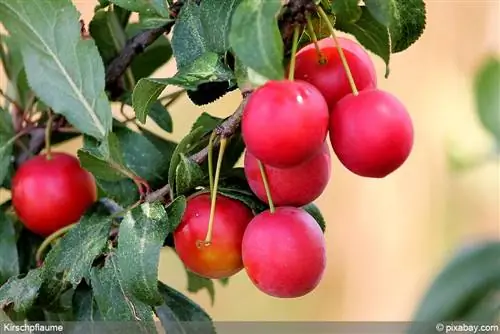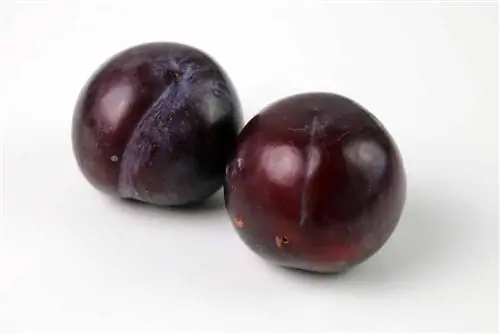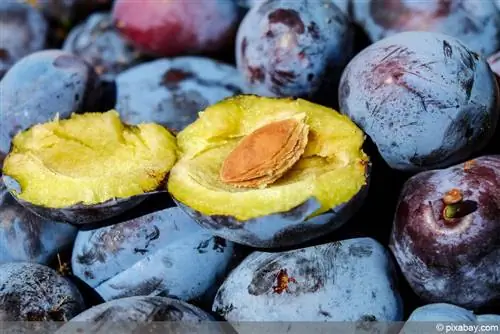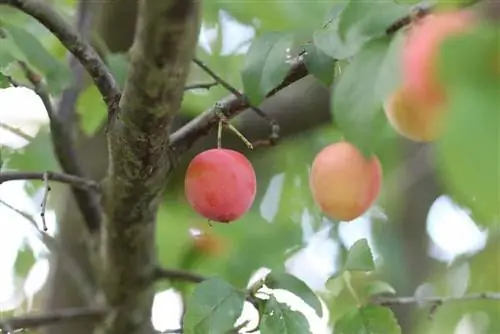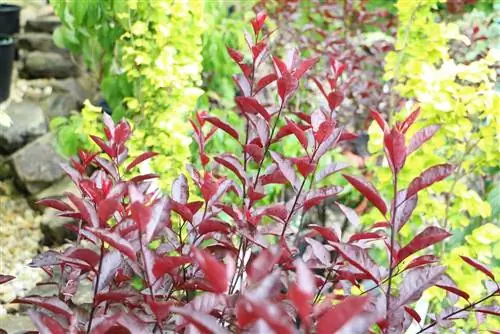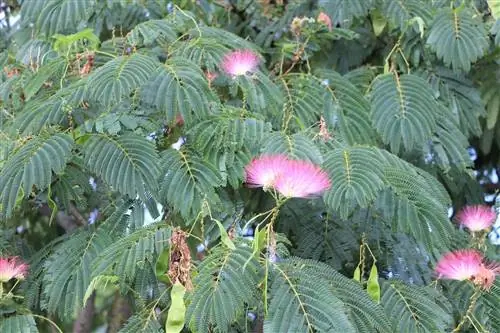- Author admin [email protected].
- Public 2023-12-17 03:39.
- Last modified 2025-01-24 12:45.
Reddish foliage, a sea of flowers in pink or white, sweet fruits and dense growth - the ornamental plum or Prunus Cerasifera, as it is known by its botanical name, can be a highlight in the garden. However, in order for it to become an ornament, appropriate care is necessary. A green thumb is not required for this. The appropriate knowledge of the requirements is sufficient.
Location
The ornamental plum is not picky when choosing a location - sun to partial shade is suitable for it. However, due to their possible size and scope, the space available should be taken into account. Depending on the type of cultivation, the cherry plum grows up to two and a half meters wide and up to seven meters tall.
If the plant is to reach such dimensions, care must be taken to maintain an appropriate distance from other plants and plants. However, a waste and thus a limitation of the size is certainly possible.
Tip:
The ornamental plum does not tolerate waterlogging, which is why locations in depressions, directly next to bodies of water or places with high groundwater are unsuitable.
Substrate
Just like the location, the ornamental plum has low demands on the substrate. It tolerates almost any soil. However, a nutrient-rich garden soil that is moderately dry or moderately moist and also deep would be optimal. If the soil in the garden is used up, adding mature compost can improve the nutrient content. Lime should be mixed into acidic soils.
If such preparation is necessary, it should preferably be done a month or more before planting. This allows the nutrients to settle and distribute and can also be processed by the organisms in the soil.
Plants
The ornamental plum can be planted from August to around October. It is important that the soil is free of frost and that the plant can be watered thoroughly. If planted in autumn, the cherry plum can bear flowers as early as next spring. However, it is also possible to plant the Prunus Cerasifera in spring. Then around March.
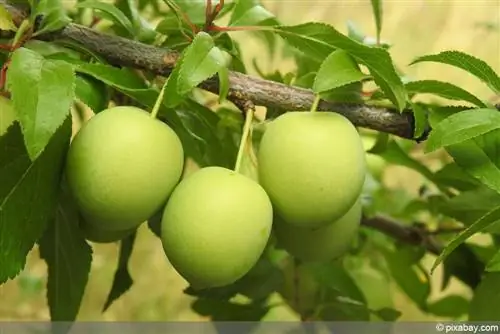
The procedure is as follows:
- For planting, a hole is dug that is at least 50 centimeters deep and wide. For larger plants, which are already commercially available up to three meters high, the planter can serve as a guide. The excavation should be at least two to three times as large as the volume of the pot.
- The hole is filled with the nutrient-rich soil mixture so that the inserted root ball is flush with the soil line as before in the bucket.
- After the soil has been tamped down, the cherry plum is poured on. During the first few weeks after planting, care should be taken to ensure that the substrate never dries out completely. This would hinder growth.
Pouring
After the initial frequent watering, the effort required for watering is reduced. Initially, the watering serves to develop the deep root system. As soon as this is available, the ornamental plum can easily look after itself.
Watering is then only necessary during longer periods without rainfall in order to avoid the soil drying out completely. It is not absolutely necessary to use rainwater or soft tap water for this. The cherry plum is not sensitive to lime.
Fertilize
It is recommended to fertilize the ornamental plum twice a year. The first fertilization can be carried out in early spring as soon as the plant shows its first shoots and leaves. Organic fertilizers such as horn shavings or compost are useful. Further fertilization is carried out when the ornamental plum sprouts flowers.
You can then use either a special flowering fertilizer or compost, nettle manure or pond water without chemical additives.
Tip:
The falling leaves of the ornamental plum can be left around the plant. They serve as protection and contribute to the supply of nutrients.
Blend
The ornamental plum is initially shaped once and then works well without any trimmings. Only dead branches should be removed regularly. This care measure not only benefits the appearance, but also the he alth of the cherry plum.
If you don't want the ornamental plum to grow too tall or serve as a privacy screen in the form of a hedge, it can certainly be trimmed. It should be noted that radical pruning leads to root runners.
It therefore makes more sense to prune the Prunus Cerasifera gently but annually. Please note the following points:
- Use only clean cutting tools
- Perform blends in the morning on a dry day
- Do not trim when there is frost
Note:
Spring or autumn are recommended times. Light thinning and the removal of dead or damaged shoots can be done at any time.
Culture in a bucket
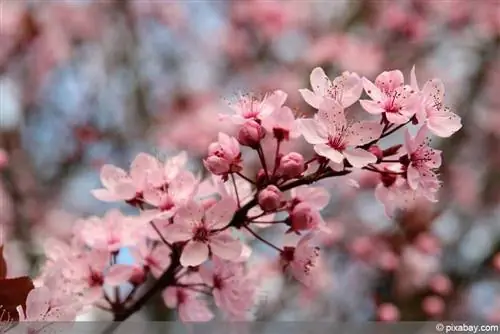
It is possible to cultivate the ornamental plum in a container. Low-growing dwarf forms, such as the Prunus Cerasifera Nigra, are ideal for this. With regular trimming, almost any ornamental plum can be easily cared for in a pot for several years. The following points and measures are important:
- Bucket should be as high as possible
- Water drainage must be ensured, for example through a drainage layer in the planter
- Frequent watering necessary to prevent the soil from drying out
- Substrate should be changed every two years
- Wintering indoors or frost protection required
Since the roots of the ornamental plum spread into the depths, it cannot provide itself as comprehensively in a pot as it can outdoors. It is therefore particularly important to water them more often and to fertilize them well.
Harvest
The ornamental plum blooms relatively early in the year, with the first splashes of color appearing between March and April. In fruit-bearing varieties, the egg-shaped plums are ready to harvest about two months later. Of course, this also depends on the climate and temperatures of the current season.
The fruits are ready to harvest when they give slightly under pressure and can be removed without any effort.
Tip:
It is recommended to remove the fruit daily to avoid falling off and rotting.
Wintering
Special winter protection is not necessary for the evergreen ornamental plum - however, it can be useful in harsh winters or for newly planted cherry plums. All you need to do is pile up some sticks or straw on the tree disc.
The situation is different with ornamental plums that are cultivated in pots. There are two options to choose from for safe wintering. The Prunus Cerasifera can either be brought indoors where it is frost-free. A bright location is not necessary. Alternatively, the following protective measures can also be followed:
- The bucket is placed on Styrofoam or a pallet to protect the substrate from below from ground frost.
- The planter is wrapped with garden fleece or jute. The smaller the bucket and the colder the winter, the more layers there should be.
- Straw, sticks or the leaves of the ornamental plum are piled up on the ground and the fleece is tied together on top.
Watering is usually not necessary during wintering. The only thing that should be avoided is that the substrate is completely dry in the fall.
Pests, diseases and care errors
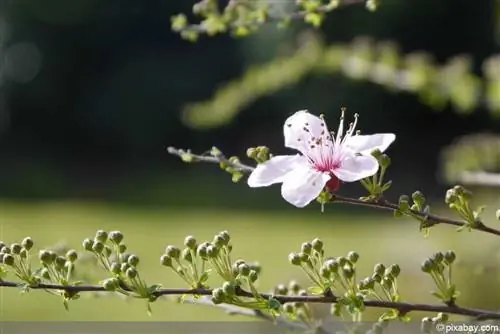
The ornamental plum is hardly susceptible to pests and diseases. Care errors are much more common. The main thing to consider here is protection against waterlogging. In the bucket, this can be provided by the drainage layer already mentioned. Outdoors, if the soil is very moist, it is a good idea to mix sand into the substrate.
Possible consequences of waterlogging include root rot, stagnant growth and the death of the ornamental plum. If the care error is noticed in time, the plant can be freed from the wet substrate, the rotten areas removed and a fungicide applied.
Conclusion
The ornamental plum is an undemanding plant that, under the right conditions, requires little attention and is therefore ideal for beginners in plant care. If you carefully choose the location and substrate, you only have to put in a little effort to achieve the flower-rich beauty.

